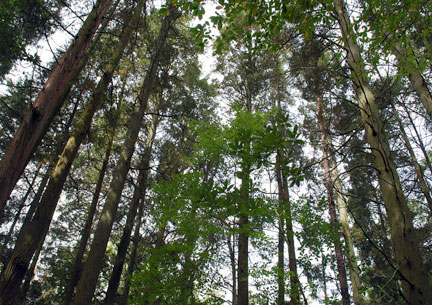762 Stage Road, Tuckerton, NJ
Phone: (609) 296-1114
www.state.nj.us/dep/parksandforests/parks/bass.html
NJ Department of Environmental Protection
From the parking lot at Amasas Landing, turn Left onto Amasas Landing Road and proceed from the sand road across the bridge over the Garden State Parkway. Continue onto Route 9 North. After 1.5 miles turn Left at the traffic light onto CR 679/ N. Maple Avenue. After 1.4 miles, bear Right at the fork onto CR 654/ West Branch Allen Road. Proceed 0.8 Miles and turn Right onto CR 654/ Stage Rd. After 1.3 miles turn Left at the sign for Bass River State Forest. DIRECTIONS FROM NEAREST HIGHWAY: From the Garden State Parkway Southbound, take Exit 52 toward New Gretna, and turn Right at CR 564/East Greenbush Road. After 1 mile turn sharp Right onto CR 654/Stage Road. After 0.8 miles turn Left at the sign for Bass River State Forest. From the Garden State Parkway Northbound, Take exit 50 toward New Gretna. Continue onto Route 9 North. After 1.5 miles turn Left at the traffic light onto CR 679/North Maple Avenue. After 1.4 miles bear Right at the fork onto CR 654/ West Branch Allen Road. After 0.8 miles, turn Right onto CR 654/ Stage Road. After 1.3 miles turn Left at the sign for Bass River State Forest. Map
Entrance fees are charged per vehicle from Memorial Day weekend to Labor Day.
$5 weekdays
$10 weekends
$2 walk in/bicycle
A superb wooden boardwalk originating near the forest office takes a visitor through a cathedral-like Atlantic white cedar bog. Look below the bridge to find three distinct species of exotic sundew plants and other endemic plant life.
Bass River State Forest is also the site of one of the earliest Civilian Conservation Corps Camps, dating back to 1933. A self-guided trail leads visitors through the remains of the old camp, and there is a memorial located on East Greenbush Road/ CR 564.
Every Saturday night in the summer months, Bass River State Forest offers interesting programs and presentations, often with a natural history perspective. These range from ’A Natural History of the Black Bear’ to ‘How to Survive Getting Lost in the Woods’ to ‘People of the Pines: a Brief History of Pineys.’
 |
| Atlantic White Cedars | Tony Geiger |
| |
| | Bass River State Forest was the first forest acquired by the state of New Jersey in 1905. It holds all of the representative habitats of the New Jersey Pine Barrens within its borders, each one accessible with a short hike. An elaborate web of hiking trails, utility right-of-ways and fire breaks extend in all directions from the main parking area adjacent to Lake Absegami. Beautiful Atlantic white cedar bogs occupy the areas upstream and downstream of Lake Absegami. Fire-maintained Pine/Oak uplands dominate the area. Absegami Natural Area has a trail passing through these habitat types and part of the Batona Trail also passes through Bass River State Forest .
West Pine Plains Natural Area is a unique stunted forest ecosystem, known locally as the Pygmy Pine Forest. It is globally rare and supports an extensive forest of pine and oak trees that may obtain a canopy height of only four feet at maturity. New Jersey contains the largest acreage of this forest community type worldwide. The area also supports an endangered plant species, the broom crowberry, and numerous rare species of moths. A Pine Plains brochure will be available at the forest office.
Look for Red-shouldered Hawk in the vicinity of the lake, as well as Bald Eagle, Red-tailed, Cooper’s and Sharp-shinned Hawks. White-tailed deer are abundant, and show their namesake as they retreat into the woods. Wood Duck, Black Duck and Mallard can be found on the lake in open water, as well as Canada Goose and Ring-billed Gull. Woodpeckers include Red-bellied, Downy, Hairy, Northern Flicker, Yellow-bellied Sapsucker, and the less common Red-headed and Pileated. Check flocks of Carolina Chickadees and Tufted Titmice for overwintering Yellow-rumped and Pine Warblers, whose splashes of yellow on gray can warm a winter day. Cross-country skiing is popular here when the conditions are right.
Vernal wetlands host leopard frogs, carpenters frogs, Fowlers toads and Pine Barrens treefrogs. The woods echo with the sweet-sweet-little-more-sweet song of Yellow Warbler, the cheerily cheerily cheerily of Common Yellowthroat, and the trills of Pine Warbler and Chipping Sparrow. Belted Kingfisher gives its rattling call near the lake, always vocal about the presence of humans.
Forster’s Terns, Tree Swallows and Barn Swallows swoop over the lake. Watch for Ruby-throated Hummingbird at the feeders outside the office. Stay alert in areas dense with blueberries for the chance of seeing the elusive black bear. Reptiles include water snakes, Eastern box turtles, red-bellied turtles, fence lizards, and the more elusive pine snake and timber rattlesnake. Bats come out at dusk over the parking area and open trails. This is the best time to look for moths as well.
Beavers and muskrats make their rounds in wetlands before ice moves in. Red and gray squirrels rustle through the forest floor. Check blooming wildflowers at trail edges and in meadows for various species of butterflies and dragonflies. Migrating raptors include Osprey, Broad-winged Hawk and Black Vulture. This is an excellent time to bring a kayak or canoe and do some fishing on the lake.
|